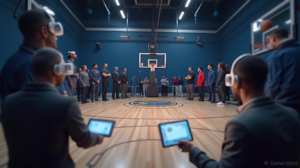Meta’s Metaverse Ambitions Challenged by ByteDance’s Swan Goggles

ByteDance Challenges Meta’s Dominance in the Mixed Reality Space
ByteDance’s Swan Goggles: A Game Changer in Mixed Reality
Mark Zuckerberg’s metaverse ambitions face a new threat as ByteDance, the parent company of TikTok, enters the mixed reality (MR) market with its innovative Swan goggles. While Meta Platforms Inc. has established a stronghold with its Quest series and the anticipated Puffin headset, ByteDance’s lightweight MR device, developed by its Pico division, is poised to disrupt the landscape.
Weighing in at a mere 0.28 pounds, the Swan goggles promise to seamlessly merge digital experiences with the real world, presenting a formidable challenge to Meta’s AI-driven augmented reality (AR) vision. ByteDance’s strategic shift from the unsuccessful Pico 5 VR headset to a focus on MR could significantly impact Meta’s substantial $16 billion investment in the metaverse.
The Lightweight Advantage of Swan
ByteDance’s Swan goggles, designed for a sleek and modern aesthetic, move away from the cumbersome VR headset format that hindered the Pico 5’s sales. With high-resolution passthrough cameras and a wired compute puck, Swan offers low-latency mixed reality experiences, effectively blending digital elements for both work and leisure.
Collaborations with Chinese suppliers and Qualcomm aim to keep production costs manageable, targeting the rapidly expanding MR market in China. However, ByteDance’s expertise in content creation may be overshadowed by potential regulatory challenges in the U.S. concerning TikTok’s data practices, which could hinder Swan’s entry into Western markets and limit its competition with Meta.
Meta’s Robust Response to ByteDance
Meta, which derives nearly all of its revenue from social media platforms such as Facebook and Instagram, has invested heavily in its Reality Labs, allocating $16 billion in 2022 alone. The company’s Quest 3S and Ray-Ban smart glasses currently lead the MR sector, with the puck-tethered Puffin headset expected to launch in 2027. Additionally, Meta’s Orion prototype features advanced eye-tracking technology, supported by new data centers in Ohio and Louisiana that bolster its AI-driven AR initiatives.
While ByteDance’s Swan goggles may offer a lighter alternative, Meta’s extensive resources and commitment to AI development position it as a formidable competitor in the mixed reality arena.
Conclusion
As the battle for dominance in the mixed reality space intensifies, the question remains: can Zuckerberg’s empire withstand the challenge posed by ByteDance’s innovative Swan goggles, or will ByteDance rise to prominence in this evolving tech landscape?







